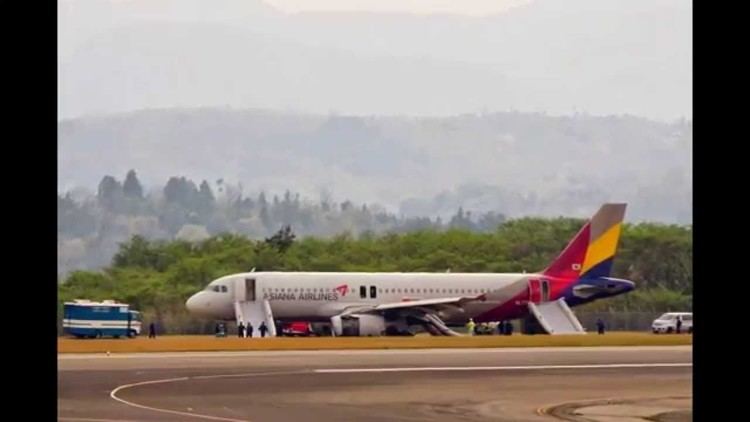Passengers 74 Injuries (non-fatal) 27 (1 serious) Date 14 April 2015 Crew count 8 | Fatalities 0 Survivors 82 (all) Number of deaths 0 Passenger count 74 | |
 | ||
Summary Impacted ground short of runway, under investigation Similar 2015 Villa Castelli mid‑air co, Trigana Air Service Flight 267, Asiana Airlines Flight 991, Korean Air Flight 2708, Korean Air Flight 85 | ||
Asiana Airlines Flight 162 (OZ162/AAR162) was a regular short-haul international passenger flight from Incheon International Airport near Seoul, South Korea, to Hiroshima Airport in Hiroshima, Japan. On 14 April 2015, the Airbus A320-232 aircraft touched down short of the runway, struck the localizer array, skidded onto the runway on its tail, and spun 120 degrees before finally coming to a rest on the grass, opposite the terminal building. The aircraft suffered substantial damage to the left wing and engine. Of the 82 people aboard, 27 (25 passengers and two crew) were injured, one seriously.
Contents
Aircraft
The aircraft involved, an Airbus A320-200 registration HL7762, was delivered new to Asiana Airlines on 12 October 2007. The aircraft was written off as a result of the incident.
Incident
The transport ministry’s Osaka Regional Civil Aviation Bureau stated that the crew tried to land the aircraft in darkness and inclement weather without access to an instrument landing system. At this airport, aircraft normally approach from the west because the instrument landing system is installed only at the eastern end of the runway. On this occasion, the pilot was instructed by an air traffic controller to approach from the east due to the wind direction. Bureau officials were reported to have stated that the pilot attempted to land in poor weather with low visibility while using such aids as the lighting near the centre-line of the runway that indicates glide angles (normally used in good weather conditions).
Investigation
The Japanese Transportation Safety Board has opened an investigation into the accident. Hiroshima Prefecture Prefectural police also launched an investigation on 15 April. South Korean investigators and airline officials traveled to Japan to join the investigation on 15 April.
On 16 April, investigators began debriefing the captain and first officer. One investigator from the Japan Transport Safety Board stated that a downdraft during approach may have contributed to the inadequate altitude at the runway threshold. The METAR (weather conditions) for the time did not indicate any unusual weather or wind shear. The weather was low overcast with almost no wind.
Recovered flight data shows that, after autopilot disconnect, the aircraft began a slow and controlled descent below the normal glide slope approach path about 4 km prior to impact. It struck the localizer 325 metres (355 yd) before the runway threshold in a nose-high attitude 148 metres (162 yd) short of the runway, with the main gear making contact with the ground 12 metres (39 ft) further on. After exiting the runway, the aircraft rotated until it came to rest facing the direction it had landed from.
